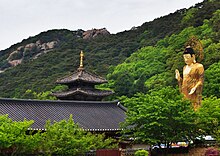Beopjusa
| Beopjusa | |
|---|---|
| 법주사 | |

View of Beopjusa Temple in South Korea
|
|
| Basic information | |
| Location | 405 Beopjusa-ro Boeun-gun North Chungcheong Province (Korean: 충청북도 보은군 속리사면 법주사로 405) |
| Geographic coordinates | 36°32′32.5″N 127°50′01.5″E / 36.542361°N 127.833750°ECoordinates: 36°32′32.5″N 127°50′01.5″E / 36.542361°N 127.833750°E |
| Affiliation | Jogye Order of Korean Buddhism |
| Country | South Korea |
Beopjusa (Korean: 법주사 or Beopju temple) is a head temple of the Jogye Order of Korean Buddhism. It is situated on the slopes of Songnisan, within Songnisan National Park, in Naesongni-myeon, Boeun County, in the province of Chungcheongbuk-do, South Korea.
It was initially constructed in 553 by Silla monk Uisin. It has been historically associated with Beopsang thought, and the worship of the Maitreya Buddha.
The founder, Uisin, named the temple Beopju (‘Residence of Dharma’) because a number of Indian sutras (scriptures about Dharma) he brought back with him were housed there. The temple with more than 60 buildings and 70 hermitages, including the highest wooden pagoda in Korea, Palsangjeon. Like most of the other buildings, this was burned to the ground in the Japanese invasions of Korea. The pagoda was reconstructed in 1624.
In the Goryeo Dynasty, this temple is said to have been home to as many as 3,000 monks. A few facilities from this period still remain on the temple grounds, including a cistern and iron pot for serving food and water to thousands of monks.
It continued to play an important role in subsequent centuries, but shrank as the state's support for Buddhism disappeared under the Joseon Dynasty. Joseon Dynasty founder Taejo is said to have retired to a spot near Beopjusa after tiring of his sons' fighting.
Beopjusa Temple owns a number of cultural heritage items: 3 national treasures; 12 miscellaneous treasures; 21 items of tangible cultural heritage of Chungcheongbukdo; and 1 item of cultural heritage material. In addition, the temple itself is designated Historic Site No. 503, the region Scenic Site No. 61, and it is also home to two natural monuments.
...
Wikipedia

